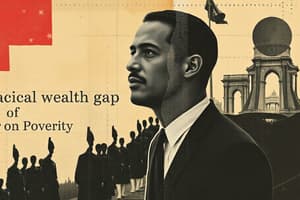Podcast
Questions and Answers
What was the impact of the ruling in Shaw v. Reno on redistricting?
What was the impact of the ruling in Shaw v. Reno on redistricting?
- It prohibited any form of redistricting.
- It mandated the creation of majority-white districts.
- It allowed racial gerrymandering.
- It was impactful on redistricting and racial gerrymandering. (correct)
The North Carolina residents who objected to the majority-minority district raised a valid question under the Fourteenth Amendment.
The North Carolina residents who objected to the majority-minority district raised a valid question under the Fourteenth Amendment.
True (A)
What precedent case was referenced in Shaw v. Reno?
What precedent case was referenced in Shaw v. Reno?
United Jewish Organization of Williamsburgh v. Carey
The court sided with ______ in Shaw v. Reno.
The court sided with ______ in Shaw v. Reno.
Match the arguments to the parties in Shaw v. Reno:
Match the arguments to the parties in Shaw v. Reno:
What did Sandra Day O'Connor state about redistricting based on race in her opinion?
What did Sandra Day O'Connor state about redistricting based on race in her opinion?
Study Notes
Facts
- Case centered on redistricting and racial gerrymandering in North Carolina.
- New district drawn to encompass majority African American population after demand from the DOJ.
- North Carolina created two additional majority-minority districts, one stretching 160 miles.
- A group of white voters, led by Ruth Shaw, filed a lawsuit against the redistricting plan.
Issues
- Central question was the validity of using race as a primary factor in district drawing under the Fourteenth Amendment's equal protection clause.
- Validity of objections by North Carolina residents regarding the majority-minority district was scrutinized.
Constitutional Provisions and Precedent Cases
- Precedent case: United Jewish Organization of Williamsburgh v. Carey.
- In that case, New York's district redrawing was upheld despite splitting a Jewish community, as it was not explicitly prohibited by the 14th or 15th Amendments.
Arguments
- Shaw's argument: Redistricting should not rely solely on race; doing so infringes on the equal protection clause of the 14th Amendment.
- North Carolina's defense: Cited the precedent set by the Jewish Organization case, arguing that redistricting based on race was valid to enhance minority representation.
Decision
- Supreme Court ruled in favor of Shaw with a narrow 5-4 decision.
- Justice Sandra Day O'Connor authored the court's opinion, stating race-based redistricting violates the 14th Amendment and the Voting Rights Act.
- Overturned the previous ruling that allowed race as a basis for redistricting but noted race could be a factor among others in drawing districts.
Studying That Suits You
Use AI to generate personalized quizzes and flashcards to suit your learning preferences.
Description
Test your knowledge on the case of redistricting and racial gerrymandering in North Carolina. Explore the legal issues surrounding the use of race in district drawing, and the implications of the Fourteenth Amendment. This quiz will cover key arguments and precedent cases related to the topic.




